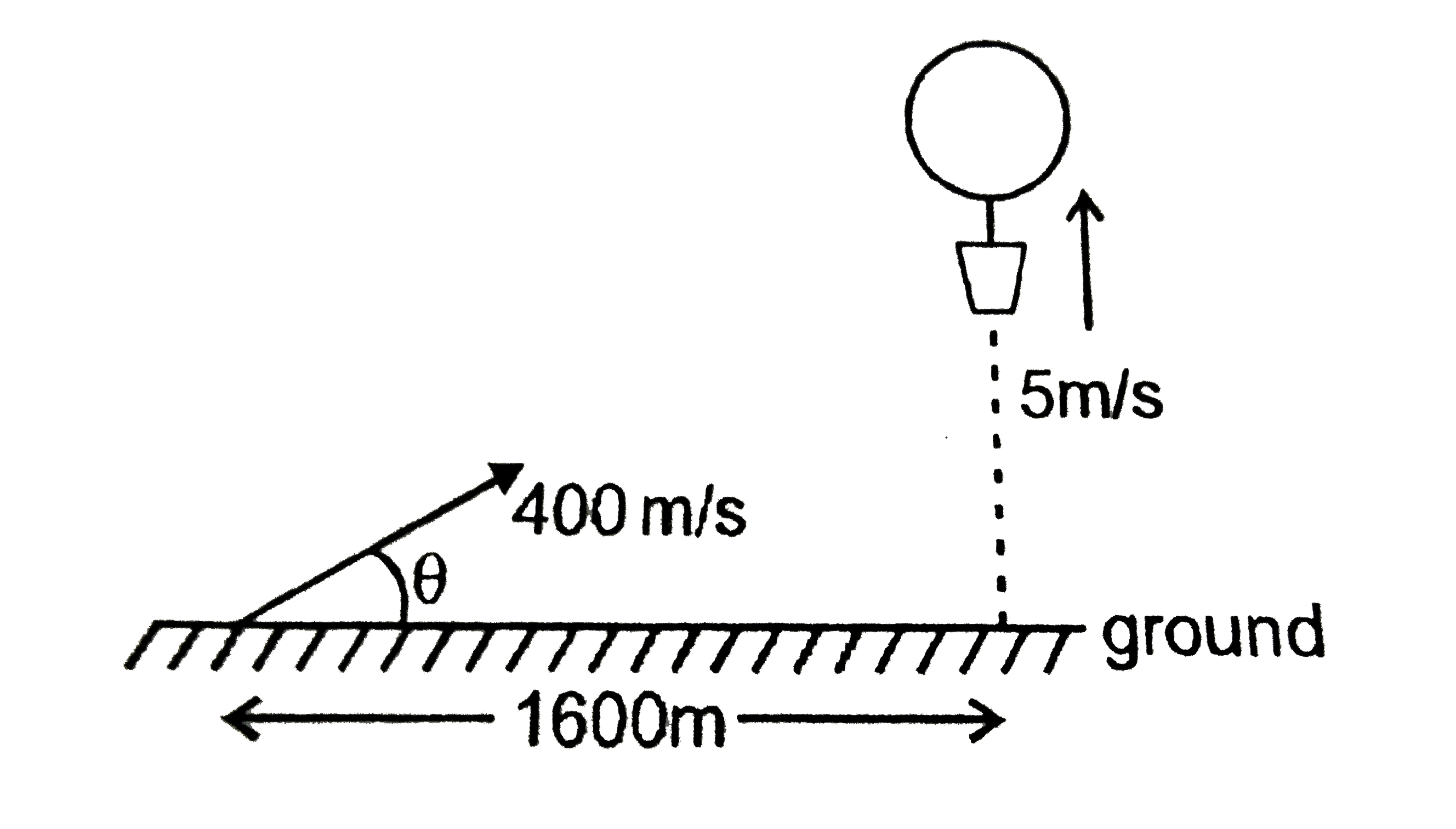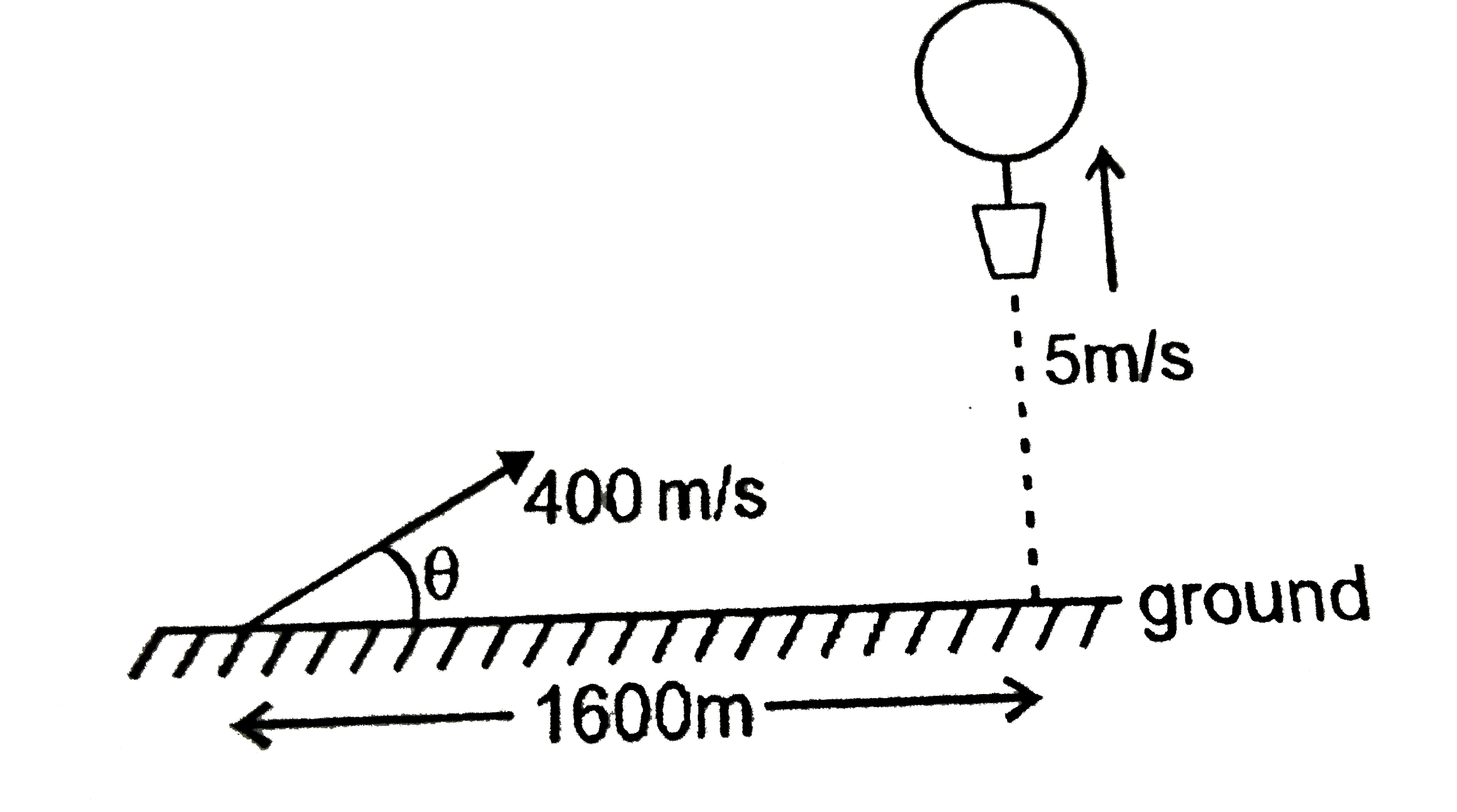An observer having a gun observes a remotely controlled balloon. When he first noticed the balloon, it was at an altitude of 800m and moving vertically upward at a constant velocity of 5m/s. The horizontal displacement of balloon from the observer is 1600m. Shells fired from the gun have an initial velocity of 400m/s at a fixed angle θ(sinθ=3/5and cosθ=4/5). The observer having gun waits ( for some time after observing the balloon ) and fires so as to destroy the balloon. Assume g=10m/s2. Neglect air resistance.

The altitude of the collosion above ground level is
1250m
1325m
1075m
1200m
The correct Answer is:C
(Easy ) The motion in the x− direction is a constant velocity motion. We find the flight time =1600mux
1600400cosθ=5sec.
Flight time =5sec.
( Easy ) From the flight time, the initial velocity in the y− direction and the acceleration in the y− direction, we can calculate the altitude of the shell:
h=uxt−12gt2=12005×5−12×10×25=1200−125=1075m
height =1075m
Topper's Solved these Questions
- BOOK - RESONANCE ENGLISHCHAPTER - DAILY PRACTICE PROBLEMSEXERCISE - dpp 707videos
DAILY PRACTICE PROBLEMS
- BOOK - RESONANCE ENGLISHCHAPTER - DAILY PRACTICE PROBLEMSEXERCISE - dpp 718videos
DAILY PRACTICE PROBLEMS
- BOOK - RESONANCE ENGLISHCHAPTER - DAILY PRACTICE PROBLEMSEXERCISE - dpp 695videos
DAILY PRACTICE PROBLEMS
- BOOK - RESONANCE ENGLISHCHAPTER - CURRENT ELECTRICITYEXERCISE - Exercise53videos
CURRENT ELECTRICITY
- BOOK - RESONANCE ENGLISHCHAPTER - ELASTICITY AND VISCOCITYEXERCISE - Advanced Level Problems9videos
ELASTICITY AND VISCOCITY
Similar Questions
An observer having a gun observes a remotely controlled balloon. When he first noticed the balloon, it was at an altitude of 800m and moving vertically upward at a constant velocity of 5m/s. The horizontal displacement of balloon from the observer is 1600m. Shells fired from the gun have an initial velocity of 400m/s at a fixed angle θ(sinθ=3/5and cosθ=4/5). The observer having gun waits ( for some time after observing the balloon ) and fires so as to destroy the balloon. Assume g=10m/s2. Neglect air resistance.

The flight time of the shell before it strikes the balloon isView SolutionAn observer having a gun observes a remotely controlled balloon. When he first noticed the balloon, it was at an altitude of 800m and moving vertically upward at a constant velocity of 5m/s. The horizontal displacement of balloon from the observer is 1600m. Shells fired from the gun have an initial velocity of 400m/s at a fixed angle θ(sinθ=3/5and cosθ=4/5). The observer having gun waits ( for some time after observing the balloon ) and fires so as to destroy the balloon. Assume g=10m/s2. Neglect air resistance.

After noticing the balloon, the time for which observer having gun waits before firing the shell isView SolutionA balloon carring a stone is moving vartically upward with velocity 12m/s. When the balloon is at height 64m, the stone is dropped. After how much time and with what velocity will it strike the ground?
View SolutionA bullet mass 10gm is fired from a gun of mass 1 kg . If the recoil velocity is 5 m/s, the velocity of the muzzle is
View SolutionA bullet mass 10gm is fired from a gun of mass 1 kg . If the recoil velocity is 5 m/s, the velocity of the muzzle is
View SolutionA bullet mass 10gm is fired from a gun of mass 1 kg . If the recoil velocity is 5 m/s, the velocity of the muzzle is
View SolutionA ball is thrown vertically upward with a velocity u from balloon descending with a constant velocity v. The vall will pass by the balloon after time
View SolutionIf θ lies in the first quadrant and 5tanθ=4, then 5sinθ−3cosθsinθ+2cosθ=
View SolutionA bullet of mass 50 g is fired from a gun with initial velocity of 35 m/s. If mass of the gun is 4 kg, then calculate the recoil velocity of the gun.
View SolutionA bullet of mass 50 g is fired from a gun with initial velocity of 35 m/s . If mass of the gun is 4 kg , then calculate the recoil velocity of the gun .
View Solution

